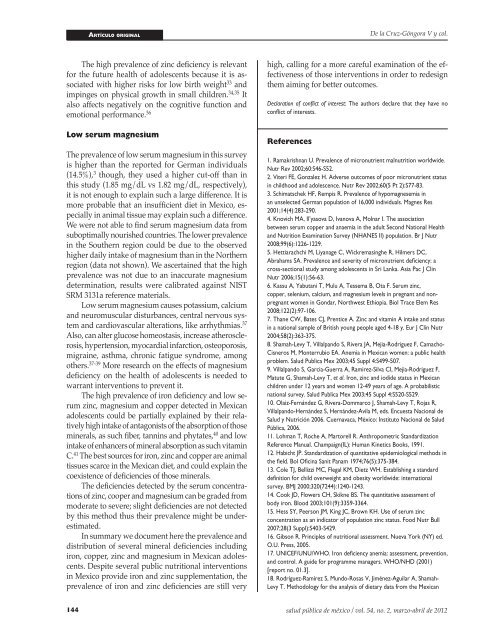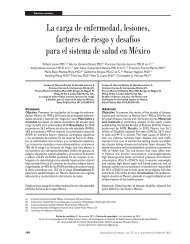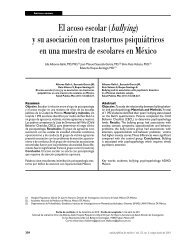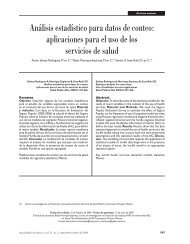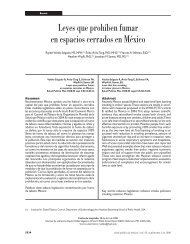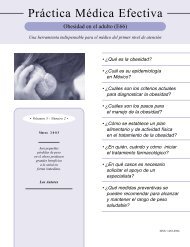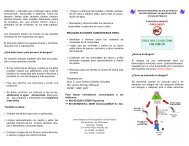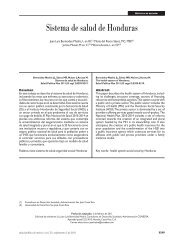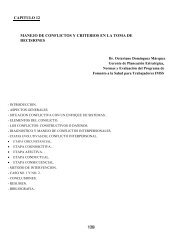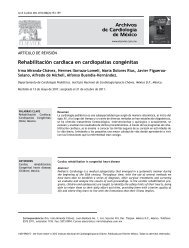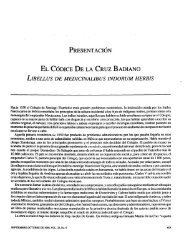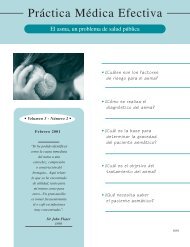Anemia and iron, zinc, copper and magnesium deficiency in ...
Anemia and iron, zinc, copper and magnesium deficiency in ...
Anemia and iron, zinc, copper and magnesium deficiency in ...
You also want an ePaper? Increase the reach of your titles
YUMPU automatically turns print PDFs into web optimized ePapers that Google loves.
Ar t í c u l o orig<strong>in</strong>Al<br />
The high prevalence of <strong>z<strong>in</strong>c</strong> <strong>deficiency</strong> is relevant<br />
for the future health of adolescents because it is associated<br />
with higher risks for low birth weight 33 <strong>and</strong><br />
imp<strong>in</strong>ges on physical growth <strong>in</strong> small children. 34,35 It<br />
also affects negatively on the cognitive function <strong>and</strong><br />
emotional performance. 36<br />
Low serum <strong>magnesium</strong><br />
The prevalence of low serum <strong>magnesium</strong> <strong>in</strong> this survey<br />
is higher than the reported for German <strong>in</strong>dividuals<br />
(14.5%), 3 though, they used a higher cut-off than <strong>in</strong><br />
this study (1.85 mg/dL vs 1.82 mg/dL, respectively),<br />
it is not enough to expla<strong>in</strong> such a large difference. It is<br />
more probable that an <strong>in</strong>sufficient diet <strong>in</strong> Mexico, especially<br />
<strong>in</strong> animal tissue may expla<strong>in</strong> such a difference.<br />
We were not able to f<strong>in</strong>d serum <strong>magnesium</strong> data from<br />
suboptimally nourished countries. The lower prevalence<br />
<strong>in</strong> the Southern region could be due to the observed<br />
higher daily <strong>in</strong>take of <strong>magnesium</strong> than <strong>in</strong> the Northern<br />
region (data not shown). We ascerta<strong>in</strong>ed that the high<br />
prevalence was not due to an <strong>in</strong>accurate <strong>magnesium</strong><br />
determ<strong>in</strong>ation, results were calibrated aga<strong>in</strong>st NIST<br />
SRM 3131a reference materials.<br />
Low serum <strong>magnesium</strong> causes potassium, calcium<br />
<strong>and</strong> neuromuscular disturbances, central nervous system<br />
<strong>and</strong> cardiovascular alterations, like arrhythmias. 37<br />
Also, can alter glucose homeostasis, <strong>in</strong>crease atherosclerosis,<br />
hypertension, myocardial <strong>in</strong>farction, osteoporosis,<br />
migra<strong>in</strong>e, asthma, chronic fatigue syndrome, among<br />
others. 37-39 More research on the effects of <strong>magnesium</strong><br />
<strong>deficiency</strong> on the health of adolescents is needed to<br />
warrant <strong>in</strong>terventions to prevent it.<br />
The high prevalence of <strong>iron</strong> <strong>deficiency</strong> <strong>and</strong> low serum<br />
<strong>z<strong>in</strong>c</strong>, <strong>magnesium</strong> <strong>and</strong> <strong>copper</strong> detected <strong>in</strong> Mexican<br />
adolescents could be partially expla<strong>in</strong>ed by their relatively<br />
high <strong>in</strong>take of antagonists of the absorption of those<br />
m<strong>in</strong>erals, as such fiber, tann<strong>in</strong>s <strong>and</strong> phytates, 40 <strong>and</strong> low<br />
<strong>in</strong>take of enhancers of m<strong>in</strong>eral absorption as such vitam<strong>in</strong><br />
C. 41 The best sources for <strong>iron</strong>, <strong>z<strong>in</strong>c</strong> <strong>and</strong> <strong>copper</strong> are animal<br />
tissues scarce <strong>in</strong> the Mexican diet, <strong>and</strong> could expla<strong>in</strong> the<br />
coexistence of deficiencies of those m<strong>in</strong>erals.<br />
The deficiencies detected by the serum concentrations<br />
of <strong>z<strong>in</strong>c</strong>, cooper <strong>and</strong> <strong>magnesium</strong> can be graded from<br />
moderate to severe; slight deficiencies are not detected<br />
by this method thus their prevalence might be underestimated.<br />
In summary we document here the prevalence <strong>and</strong><br />
distribution of several m<strong>in</strong>eral deficiencies <strong>in</strong>clud<strong>in</strong>g<br />
<strong>iron</strong>, <strong>copper</strong>, <strong>z<strong>in</strong>c</strong> <strong>and</strong> <strong>magnesium</strong> <strong>in</strong> Mexican adolescents.<br />
Despite several public nutritional <strong>in</strong>terventions<br />
<strong>in</strong> Mexico provide <strong>iron</strong> <strong>and</strong> <strong>z<strong>in</strong>c</strong> supplementation, the<br />
prevalence of <strong>iron</strong> <strong>and</strong> <strong>z<strong>in</strong>c</strong> deficiencies are still very<br />
De la Cruz-Góngora V y col.<br />
high, call<strong>in</strong>g for a more careful exam<strong>in</strong>ation of the effectiveness<br />
of those <strong>in</strong>terventions <strong>in</strong> order to redesign<br />
them aim<strong>in</strong>g for better outcomes.<br />
Declaration of conflict of <strong>in</strong>terest: The authors declare that they have no<br />
conflict of <strong>in</strong>terests.<br />
References<br />
1. Ramakrishnan U. Prevalence of micronutrient malnutrition worldwide.<br />
Nutr Rev 2002;60:S46-S52.<br />
2. Viteri FE, Gonzalez H. Adverse outcomes of poor micronutrient status<br />
<strong>in</strong> childhood <strong>and</strong> adolescence. Nutr Rev 2002;60(5 Pt 2):S77-83.<br />
3. Schimatschek HF, Rempis R. Prevalence of hypomagnesemia <strong>in</strong><br />
an unselected German population of 16,000 <strong>in</strong>dividuals. Magnes Res<br />
2001;14(4):283-290.<br />
4. Knovich MA, Il’yasova D, Ivanova A, Molnar I. The association<br />
between serum <strong>copper</strong> <strong>and</strong> anaemia <strong>in</strong> the adult Second National Health<br />
<strong>and</strong> Nutrition Exam<strong>in</strong>ation Survey (NHANES II) population. Br J Nutr<br />
2008;99(6):1226-1229.<br />
5. Hettiarachchi M, Liyanage C, Wickremas<strong>in</strong>ghe R, Hilmers DC,<br />
Abrahams SA. Prevalence <strong>and</strong> severity of micronutrient <strong>deficiency</strong>: a<br />
cross-sectional study among adolescents <strong>in</strong> Sri Lanka. Asia Pac J Cl<strong>in</strong><br />
Nutr 2006;15(1):56-63.<br />
6. Kassu A, Yabutani T, Mulu A, Tessema B, Ota F. Serum <strong>z<strong>in</strong>c</strong>,<br />
<strong>copper</strong>, selenium, calcium, <strong>and</strong> <strong>magnesium</strong> levels <strong>in</strong> pregnant <strong>and</strong> nonpregnant<br />
women <strong>in</strong> Gondar, Northwest Ethiopia. Biol Trace Elem Res<br />
2008;122(2):97-106.<br />
7. Thane CW, Bates CJ, Prentice A. Z<strong>in</strong>c <strong>and</strong> vitam<strong>in</strong> A <strong>in</strong>take <strong>and</strong> status<br />
<strong>in</strong> a national sample of British young people aged 4-18 y. Eur J Cl<strong>in</strong> Nutr<br />
2004;58(2):363-375.<br />
8. Shamah-Levy T, Villalp<strong>and</strong>o S, Rivera JA, Mejia-Rodriguez F, Camacho-<br />
Cisneros M, Monterrubio EA. <strong>Anemia</strong> <strong>in</strong> Mexican women: a public health<br />
problem. Salud Publica Mex 2003;45 Suppl 4:S499-507.<br />
9. Villalp<strong>and</strong>o S, Garcia-Guerra A, Ramirez-Silva CI, Mejia-Rodriguez F,<br />
Matute G, Shamah-Levy T, et al. Iron, <strong>z<strong>in</strong>c</strong> <strong>and</strong> iodide status <strong>in</strong> Mexican<br />
children under 12 years <strong>and</strong> women 12-49 years of age. A probabilistic<br />
national survey. Salud Publica Mex 2003;45 Suppl 4:S520-S529.<br />
10. Olaiz-Fernández G, Rivera-Dommarco J, Shamah-Levy T, Rojas R,<br />
Villalp<strong>and</strong>o-Hernández S, Hernández-Avila M, eds. Encuesta Nacional de<br />
Salud y Nutrición 2006. Cuernavaca, México: Instituto Nacional de Salud<br />
Pública, 2006.<br />
11. Lohman T, Roche A, Martorell R. Anthropometric St<strong>and</strong>ardization<br />
Reference Manual. Champaign(IL): Human K<strong>in</strong>etics Books, 1991.<br />
12. Habicht JP. St<strong>and</strong>ardization of quantitative epidemiological methods <strong>in</strong><br />
the field. Bol Ofic<strong>in</strong>a Sanit Panam 1974;76(5):375-384.<br />
13. Cole TJ, Bellizzi MC, Flegal KM, Dietz WH. Establish<strong>in</strong>g a st<strong>and</strong>ard<br />
def<strong>in</strong>ition for child overweight <strong>and</strong> obesity worldwide: <strong>in</strong>ternational<br />
survey. BMJ 2000;320(7244):1240-1243.<br />
14. Cook JD, Flowers CH, Skikne BS. The quantitative assessment of<br />
body <strong>iron</strong>. Blood 2003;101(9):3359-3364.<br />
15. Hess SY, Peerson JM, K<strong>in</strong>g JC, Brown KH. Use of serum <strong>z<strong>in</strong>c</strong><br />
concentration as an <strong>in</strong>dicator of population <strong>z<strong>in</strong>c</strong> status. Food Nutr Bull<br />
2007;28(3 Suppl):S403-S429.<br />
16. Gibson R. Pr<strong>in</strong>ciples of nutritional assessment. Nueva York (NY) ed.<br />
O.U. Press, 2005.<br />
17. UNICEF/UNU/WHO. Iron <strong>deficiency</strong> anemia: assessment, prevention,<br />
<strong>and</strong> control. A guide for programme managers. WHO/NHD (2001)<br />
[report no. 01.3].<br />
18. Rodríguez-Ramírez S, Mundo-Rosas V, Jiménez-Aguilar A, Shamah-<br />
Levy T. Methodology for the analysis of dietary data from the Mexican<br />
144 salud pública de méxico / vol. 54, no. 2, marzo-abril de 2012


